Woodpecker
They have zygodactyl feet, with the first and fourth toes facing backward, the second and third facing forward, so they can grip tree trunks more efficiently
Advertisement
Woodpecker Scientific Classification
Read our Complete Guide to Classification of Animals.
Woodpecker Conservation Status
Woodpecker Facts
- Main Prey
- Seeds, Fruit, Insects
- Fun Fact
- They have zygodactyl feet, with the first and fourth toes facing backward, the second and third facing forward, so they can grip tree trunks more efficiently
- Wingspan
- Up to 30 inches
- Incubation Period
- 11 days to two weeks
- Habitat
- Dense forest and woodland
- Predators
- Rat, Snakes, Wild cats
- Diet
- Omnivore
- Lifestyle
- Solitary
- Favorite Food
- Seeds
- Type
- Bird
- Average Clutch Size
- 4
- Slogan
- There are 200 different species!
- Nesting Location
- Holes in the trunks of trees
- Age of Molting
- late summer within the first year
View all of the Woodpecker images!
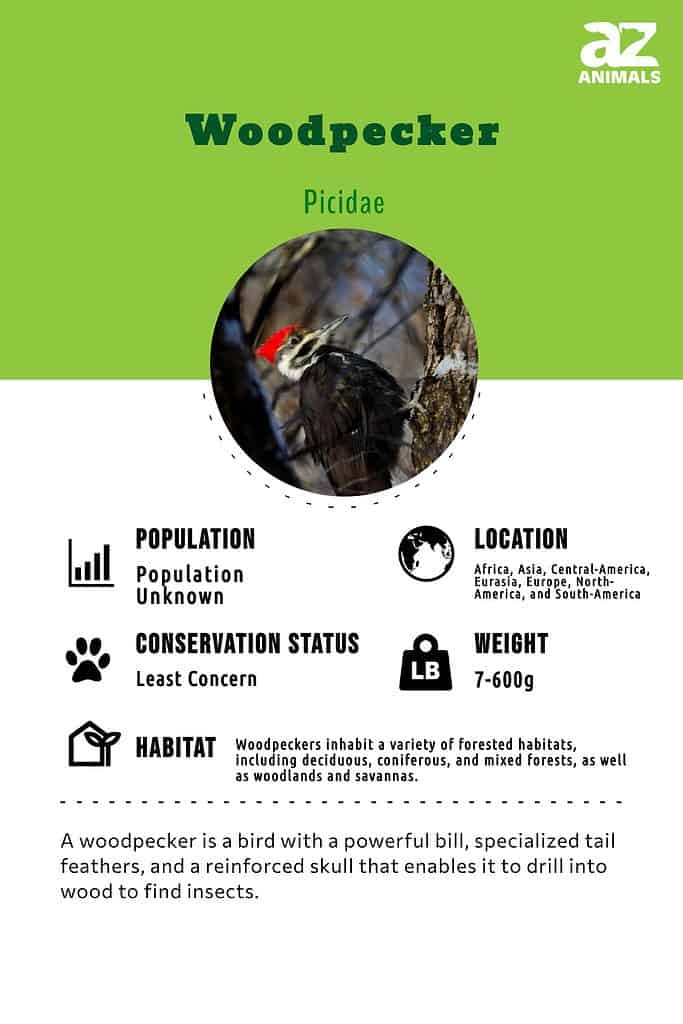
Woodpeckers are birds that have zygodactyl feet, with the first and fourth toes facing backward, and the second and third facing forward, so they can grip tree trunks more efficiently
Woodpeckers are birds that live in nearly every region of the world except for New Guinea, New Zealand, Madagascar, Australia, and both the North and South Poles. The family Picidae includes 236 species of woodpeckers. About 20 of these species are in danger of extinction.
An Amazing Bird: Woodpecker Facts!
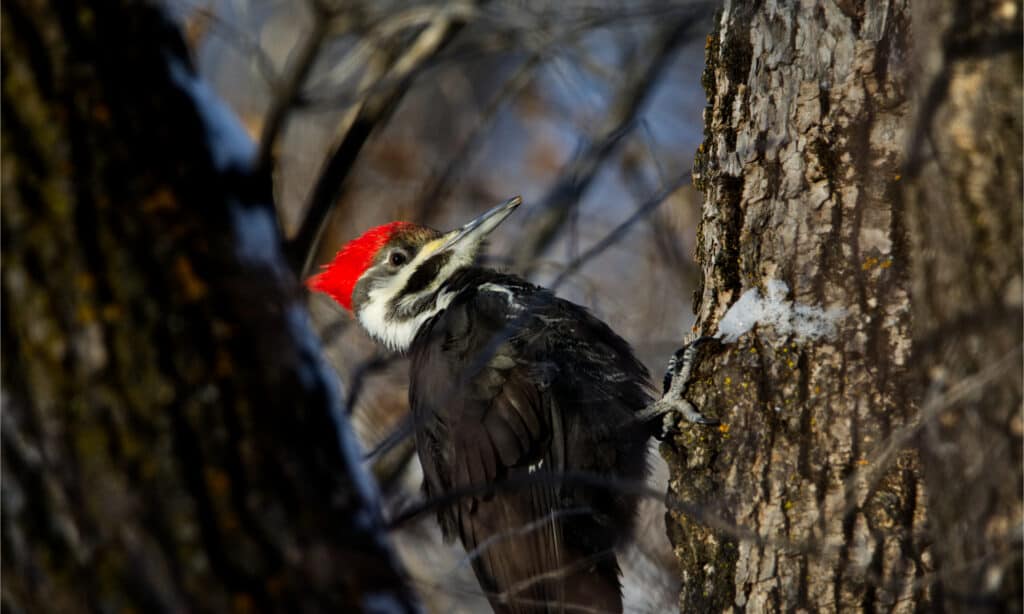
A woodpecker’s tongue is typical twice the length of its beak, able to reach into crevices for insects. The bird’s tongue or its saliva is sticky, too, so it can cling to its prey.
©Michael Dante Salazar/Shutterstock.com
- A woodpecker’s tongue is typical twice the length of its beak, able to reach into crevices for insects. The bird’s tongue or its saliva is sticky, too, so it can cling to its prey.
- The woodpecker’s tongue wraps around the back of its head between the tissue and the bone, acting as a shock absorber when the bird is drumming.
- Woodpeckers are birds with feathers on their noses that keep wood debris out of the bird’s nostrils while it is boring holes.
- Woodpeckers use their jackhammer-like beaks to dig out bugs, but they also drum their bills to create rhythms for attracting mates, staking a claim, and sometimes, just for fun.
- Woodpeckers can grow to incredible sizes! The largest woodpecker ever, the imperial woodpecker was nearly 23 inches in length but is potentially extinct today.
Where to Find Woodpeckers
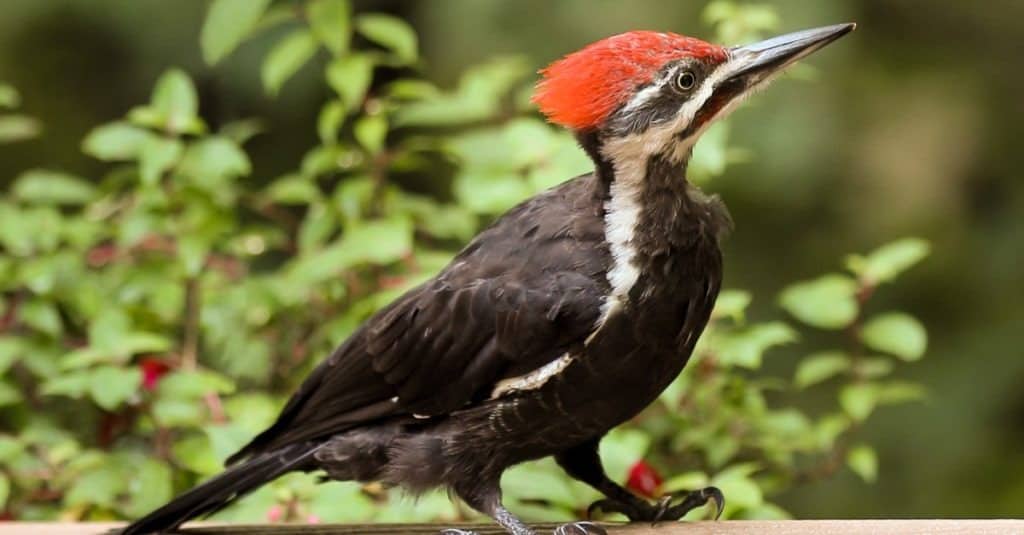
Woodpeckers live almost everywhere in the world, wherever there are woodsy habitats.
©James.Pintar/Shutterstock.com
Woodpeckers live almost everywhere in the world, wherever there are woodsy habitats. A small number of species prefer rocky areas instead, and one species, the Gila woodpecker, subsists on a diet of cacti in its desert habitat. These birds do not live in the extreme polar regions of Australasia or Madagascar.
Scientific Name

The International Ornithological Congress recognizes 236, all of which belong to the Picidae family.
©Ondrej Prosicky/Shutterstock.com
Although experts disagree on the total number of woodpecker species, the International Ornithological Congress recognizes 236, all of which belong to the Picidae family. They are divided into 36 genera within this family.
Evolution and Origins
Woodpeckers are a fascinating group of birds known for their unique behavior of drilling into trees and other wooden structures with their powerful bills. These birds belong to the family Picidae, which consists of around 240 species worldwide. In this article section, we will explore the evolution and origins of woodpeckers.
The earliest known fossil of a woodpecker-like bird is from the late Eocene period, around 35 million years ago. This fossil, known as Eopicius, was discovered in Wyoming and is believed to be an ancestor of modern woodpeckers. Over time, woodpeckers evolved specialized adaptations that enabled them to excavate wood and feed on insects that are found in it.
One of the most distinctive features of woodpeckers is their powerful bills, which are used for drilling into trees and other wooden structures. The bills are made of a hard material called keratin, which is the same material that makes up human hair and nails. The bill is also shaped like a chisel, with a sharp edge that is used to chisel away wood. In addition to the bill, woodpeckers have a long, sticky tongue that they use to extract insects from deep within the wood.
Woodpeckers have also evolved a unique way of perching on trees, which involves using their stiff tail feathers to prop themselves up. These feathers are known as the rectrices and are located at the base of the tail. They are used to provide support and stability when the bird is drilling into wood.
Common Types of Woodpeckers
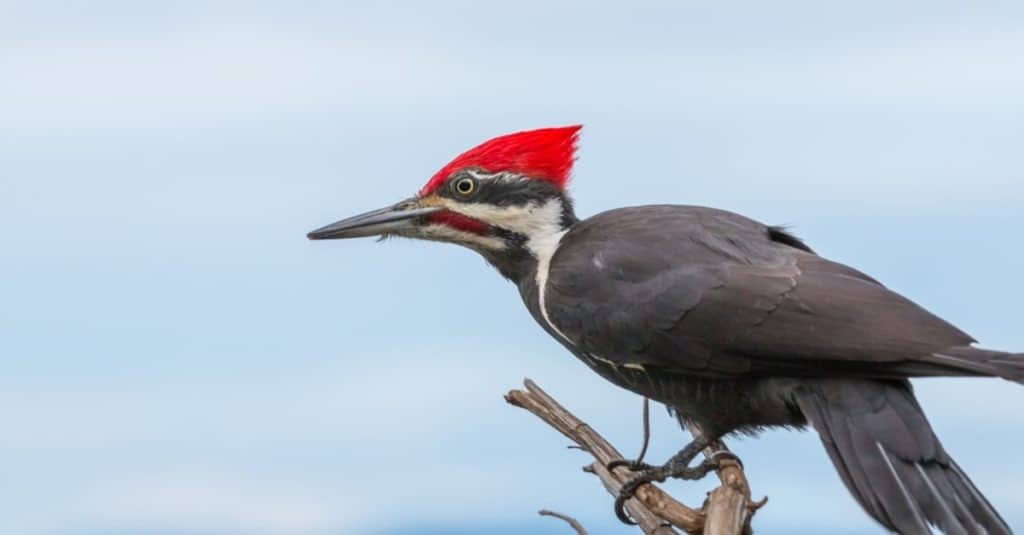
The downy woodpecker is the smallest type of woodpecker in North America, measuring up to 7 inches long
©rhfletcher/Shutterstock.com
- Downy Woodpecker – The downy woodpecker is the smallest type of woodpecker in North America, measuring up to 7 inches long. They generally live in forested areas within tree cavities that are hollowed out by nesting pairs.
- Gila Woodpecker – The Gila woodpecker is a medium-sized woodpecker that inhabits the southwestern United States and western Mexico and ranges from 8 to 10 inches in size. These woodpeckers prefer to nest in saguaro cacti in the low desert scrub of the Sonoran desert.
- Hairy Woodpecker – The hairy woodpecker grows to approximately 10 inches in length and is similar in appearance to the downy woodpecker. These birds are known to follow pileated woodpeckers and pick through insects that the larger birds may have missed.
- Pileated Woodpecker – The pileated woodpecker is a large species that can grow up to 19 inches in length and is native to North America. These birds prefer mature forests and excavate large holes within dead trees to roost at night.
- Yellow-Bellied Sapsucker – The yellow-bellied sapsucker ranges from 7-8 inches in size and inhabits Canada and the northeastern United States. These birds are migratory, traveling as far south as Panama in the summer months.
List of woodpecker species:
- Red-headed woodpecker
- Pileated woodpecker
- Red-bellied woodpecker
- Northern flicker
- Yellow-bellied sapsucker
- Ladder-backed woodpecker
- Black-backed woodpecker
- Lewis’s woodpecker
- Red-cockaded woodpecker
- Gila woodpecker
- Ivory-billed woodpecker
- American three-toed woodpecker
- Acorn woodpecker
- Golden-fronted woodpecker
- White-headed woodpecker
- Nuttall’s woodpecker
- Hairy woodpecker
- Red-naped sapsucker
- Williamson’s sapsucker
- Red-breasted sapsucker
- Gilded flicker
- Arizona woodpecker
- Great spotted woodpecker
- White woodpecker
- Imperial woodpecker
- Eurasian wryneck
- Eurasian three-toed woodpecker
- Black woodpecker
- European green woodpecker
- Great slaty woodpecker
- Arabian woodpecker
- Magellanic woodpecker
- Smoky-brown woodpecker
- Lesser spotted woodpecker
- Red-crowned woodpecker
- Grey-headed woodpecker
- Black-headed woodpecker
- Hemicircus sordidus
- Campo flicker
- Andean flicker
- Grey-capped pygmy woodpecker
- Rufous-bellied woodpecker
- Bamboo woodpecker
- Hispaniolan woodpecker
- West Indian woodpecker
- Bar-breasted piculet
- Ochre-collared piculet
- African piculet
- Middle spotted woodpecker
- White-backed woodpecker
Size, Appearance & Behavior
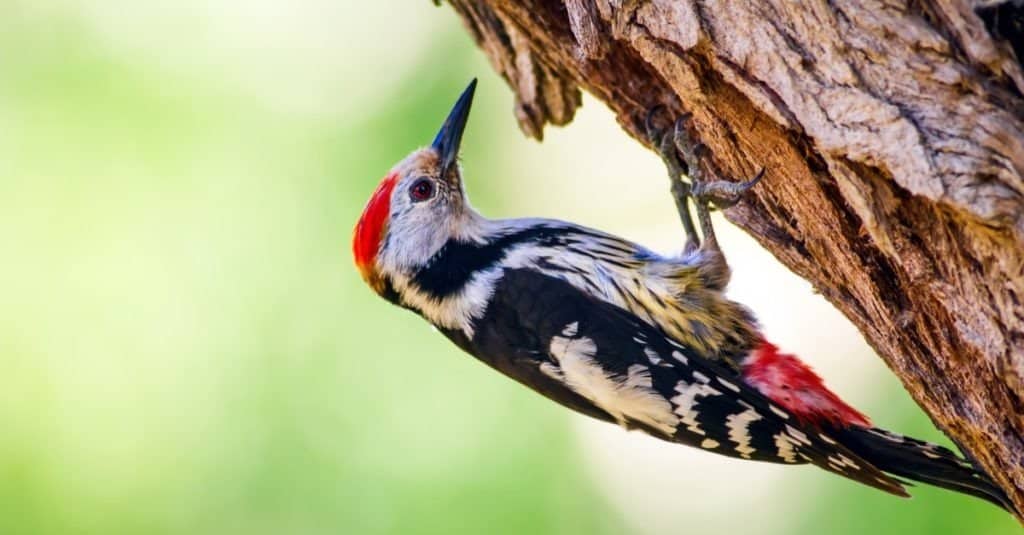
Ranging in size from the tiny piculet, which measures less than three inches from tip to tail, to the pileated and great slaty woodpeckers, which measure up to 20 inches in length.
©serkan mutan/Shutterstock.com
Ranging in size from the tiny piculet, which measures less than three inches from tip to tail, to the pileated and great slaty woodpeckers, which measure up to 20 inches in length, the size of these distinctive birds varies significantly.
With a few exceptions, all woodpeckers share distinctive features, though, such as:
- A chisel-tipped beak
- Zygodactyl feet with opposing toes
- A contrasting crest or feathery tuft on the crown
- Strong short legs
- Stiff tail for balance
- Exceptionally long, sticky tongues
- Shock-absorbing skull bone
- Nostril feathers to prevent inhaling debris
Woodpeckers are not songbirds, but both males and females do vocalize to express warnings, attraction, and territorialism. Their range of calls includes:
- Twitters
- Trills
- Whistles
- Chattering
- Shrieks
- Wails
- Rattles
Each species sounds somewhat different, but the sounds they make are loud enough to travel in densely forested habitats. Even baby nestlings communicate with their parents with sounds.
Most species do not migrate but remain in their chosen habitat year-round. Two types that do migrate are the yellow-shafted flicker of the eastern U.S., whose scientific name is Colaptes auratus, and the North American yellow-bellied sapsucker, whose scientific name is Sphyrapicus varius.
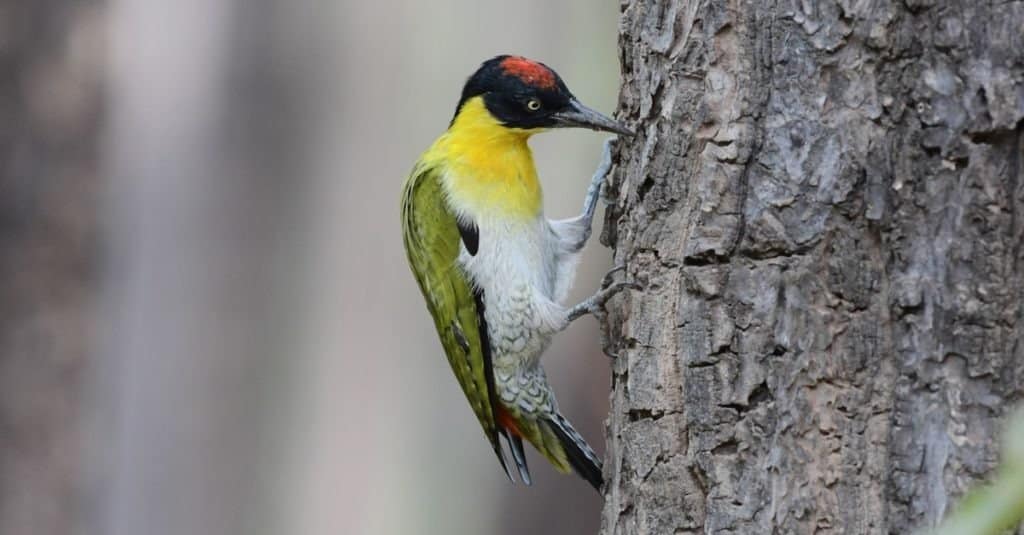
©Lovely Bird/Shutterstock.com
Diet
Insects and their larvae are the mainstays of the woodpecker’s diet, but they eat other foods too. Birds’ eggs, baby birds, small rodents, or reptiles are all part of a woodpecker’s diet if they are available. As omnivores, woodpeckers eat fruit, nuts, and even tree sap.
Like most birds, the woodpecker plays an important role in the health of the natural environment. By boring holes in trees and extracting insects with its long, sticky tongue, this bird helps prevent potentially harmful insect damage. For example, woodpeckers eat the larvae of the emerald ash borer beetle, which was responsible for the destruction of millions of ash trees in North America.
In turn, three woodpecker species have benefitted as well. The red-bellied, downy, and hairy woodpecker species have enjoyed a population surge since adding the emerald ash borer beetle to their diets.
The Bird’s Predators and Threats
Loss of habitat due to human encroachment is the most significant threat to woodpeckers worldwide. For example, insecticides that big agricultural companies use to eliminate crop-eating pests wipe out a major food source for the local woodpecker population.
In the natural environment, woodpeckers are under threat from predators even before they hatch. Snakes and birds like grackles steal in and eat the eggs in an unprotected nest. Feline predators of adult birds include feral cats, bobcats, and mountain lions. Some of the canine threats include foxes and coyotes. Larger birds of prey such as hawks may also consider woodpeckers to be part of a balanced diet.
Reproduction, Babies, and Lifespan
Woodpeckers will nest in existing holes in tree trunks, but when necessary, they will excavate their own. Some woodpeckers will even nest in a telephone pole or a human dwelling. Most species use a nesting site for a single breeding season and then move on.
Woodpeckers are monogamous with a few exceptions. For example, acorn woodpeckers may establish a breeding group of up to 12 birds and then raise the nestlings together.
Females lay two to five eggs. Because they are protected within the tree trunk, woodpecker eggs have a better chance of hatching into live chicks than those in more exposed nests. Both parents take turns keeping the eggs warm for 12-14 days of incubation.
Once a baby first hatches, it develops quickly and is ready to leave the nest in about 30 days. On average, woodpeckers live between four and 12 years. Some can live up to 30 years if environmental conditions are just right.
Population
Of the 250 recognized woodpecker species, approximately 20 have dwindled to dangerously low numbers, mainly due to habitat loss. The Bermuda flicker is now extinct. The ivory-billed, imperial, and Okinawa woodpeckers are all on the critically endangered list. In fact, many ornithologists believe that the imperial and ivory-billed species are probably extinct.
View all 108 animals that start with WWoodpecker FAQs (Frequently Asked Questions)
Are Woodpeckers herbivores, carnivores, or omnivores?
Woodpeckers are Omnivores, meaning they eat both plants and other animals.
What Kingdom do Woodpeckers belong to?
Woodpeckers belong to the Kingdom Animalia.
What class do Woodpeckers belong to?
Woodpeckers belong to the class Aves.
What phylum to Woodpeckers belong to?
Woodpeckers belong to the phylum Chordata.
What family do Woodpeckers belong to?
Woodpeckers belong to the family Picidae.
What order do Woodpeckers belong to?
Woodpeckers belong to the order Piciformes.
Are woodpeckers omnivores?
Yes, woodpeckers eat both meat and vegetable matter. Their diet includes insects, grubs, birds’ eggs, and small rodents as well as fruit, nuts, and tree sap.
What eats woodpeckers?
Bobcats, coyotes, foxes, and hawks are some of the predators that eat woodpeckers. Snakes and other birds also rob their nests of eggs.
What does a woodpecker look like?
Many species have red heads or a red crest on their head. Many are black and white. They have long, pointed beaks strong enough to peck through wood. Most woodpeckers have four opposable toes on each foot that end in claws. One exception is the American three-toed woodpecker.
Where do woodpeckers live?
Woodpecker species live throughout the world except for the North and South poles, Australia, New Zealand, Madagascar, and New Guinea. Most of them inhabit forested environments, although some live on rocky hillsides or in desert terrain.
What does a woodpecker sound like?
The drumming of the woodpecker’s bill on a tree is the most distinctive sound this bird makes. It also makes a loud, brief call, trills, cackles, whistles, churrs, and tweets. Most of their vocalizations relate to protecting their territory or attracting and communicating with a mate.
Do woodpeckers migrate?
Only a small percentage of woodpecker species migrate. Most inhabit their forests year-round. The yellow-shafted flicker and the yellow-bellied sapsucker, both native to North America, are two of the migrating species.
How many eggs does a woodpecker lay?
Most woodpeckers lay two to five eggs each mating season.
How fast does woodpeckers fly?
Speed is not a typical woodpecker trait. Their flight pattern consists of a few wing flaps and then a soaring dive, so they do not move very quickly from point A to point B. These birds spend most of their lives in the trees, searching for food. An enterprising bird can peck up to 20 times per second, either when feeding on a termite nest or to warn off intruders.
What is a woodpecker’s wingspan?
The woodpecker’s wingspan depends upon the species of the bird. For example, a pileated woodpecker, one of the largest species, has a wingspan of up to 30 inches. In contrast one of the tiniest woodpeckers, the piculet, is less than 3 inches long with a wingspan to match its size.
When do woodpeckers leave the nest?
Woodpeckers are ready to leave the nest when they are around one month old.
What type of covering do Woodpeckers have?
Woodpeckers are covered in Feathers.
What is the main prey for Woodpeckers?
Woodpeckers eat seeds, fruit, and insects.
What is an interesting fact about Woodpeckers?
There are 200 different species of Woodpecker!
What is the lifespan of a Woodpecker?
Woodpeckers can live for 6 to 11 years.
How do Woodpeckers have babies?
Woodpeckers lay eggs.
What's the diferrence between a Hairy Woodpecker and a Downy Woodpecker?
The main differences between Hairy Woodpeckers and Downy Woodpeckers are their bills, head and body, size, tail, and habitat.
Thank you for reading! Have some feedback for us? Contact the AZ Animals editorial team.
Sources
- Wikipedia, Available here: https://en.wikipedia.org/wiki/Woodpecker
- FLIGHT-FEATHER NORTH AMERICAN MOLT PATTERNS AND AGE IN WOODPECKERS, Available here: chrome-extension://ohfgljdgelakfkefopgklcohadegdpjf/http://www.prbo.org/refs/files/11209_Pyle+S.N.G.Howell.1995.pdf
- Audubon, Available here: https://www.audubon.org/field-guide/bird/pileated-woodpecker
- Hickory Knolls Discovery Center, Available here: https://www.stcnature.org/characteristics-of-pileated-woodpeckers/
- Penn State Extension, Available here: https://extension.psu.edu/woodpeckers
- Dickinson County Conservation Board, Available here: https://dickinsoncountyconservationboard.com/2018/10/10/nine-fun-facts-about-woodpeckers/
- USDA Forest Service, Available here: https://www.nrs.fs.fed.us/news/release/woodpeckers-and-eab
- AZ Central, Available here: https://www.azcentral.com/story/claythompson/2014/05/25/clay-thompson-arizona-humor-woodpeckers-woodpecker-predators/9400273/
- Britannica, Available here: https://www.britannica.com/animal/woodpecker
- The Spruce, Available here: https://www.thespruce.com/fun-facts-about-woodpeckers-387095

















